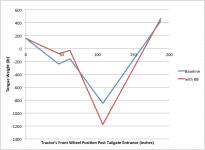I ran through a full on calculation of tongue weight that would occur while driving my
B2920 into the trailer, with and without the box blade. You can see the results in the attached graph. It's very interesting -- start out at the nominal 160 lb of tongue weight from the empty trailer, and then it begins creeping down and goes negative as the front tractor tire rides up the tailgate ramp. That increases slightly (but still negative) as the front tire rides along the deck, and then decreases significantly as the rear tire starts riding up the ramp. Once both tires are on the deck and the tractor moves forward, tongue weight increases and eventually goes positive again. Eventually, it gets in the 400-450 lb range which is inline with 10% of the trailer+tractor weight. Note: these are all dead loads -- live loads could add to that.
So it looks like the worst I will see is about -1200 lb of tongue weight (or +1200 lb of lift if you want to think of it that way). That's not enough to lift the back of the MDX off the ground, but it's still offsetting about 2/3 of the normal rear axle load, so the rear suspension will probably be extended quite a bit (and the front will dive a bit). I think I will try to avoid this alltogether by blocking up the back of the trailer before I drive on -- leaving about 2" of space between the blocks and trailer as a first guess (can always back off and readjust blocks if they get pinched by the loaded trailer).
Once I can study the actual behavior, then I can decide if jacks make sense. I found some Fulton stabilizer jacks good for 3000lb each. They are square tube, locked with a pin, and slide within 2" tube that can be welded to the trailer frame:
Fulton Drop-Leg Stabilizer Jack with Mounting Channel - Weld-On - 20" Leg - 13" Bracket - Fulton Trailer Jack FSJ1-SJ4
Now, interestingly, you can also buy just the drop leg:
Fulton Square Drop Leg for Stabilizer Jack, 20" Long Fulton Trailer Jack FSJ40324
My trailer happens to use a 2" tube for the rearmost rail post. It carries tail light wires right now, but if I can re-route the wires, that leaves a nice long 14" tube that could hold the drop leg. I can then drill a 1/2" hole in the tube, and slide a pin in there to position the drop leg. That might end up being a pretty slick way to get it done without having to weld anything. I just need to make sure there will be enough range of motion for ground clearance when the leg is up, and support when the leg is down. The trailer has about 16" of ground clearance at the rear, so a 20" leg inside a 14" tube would eat up 6" of ground clearance at the back (leaving 10" -- not bad) and give me 4-6" of leg inside the tube when extended. Seems like it might fly.


